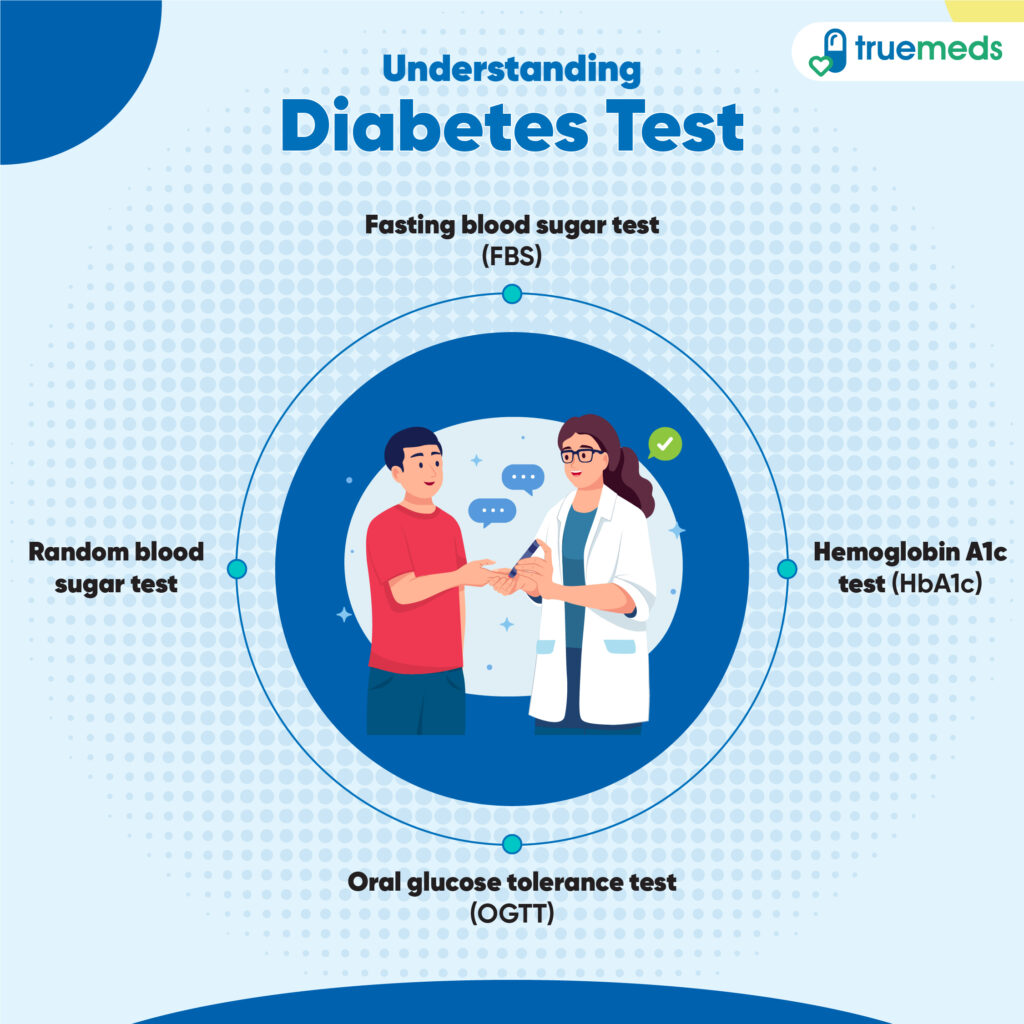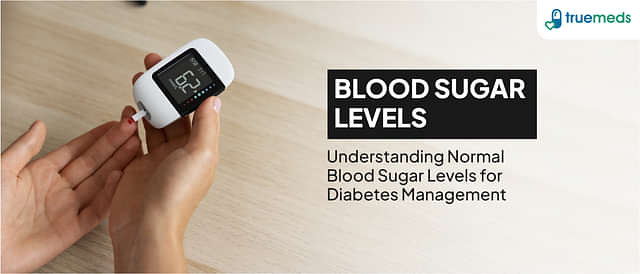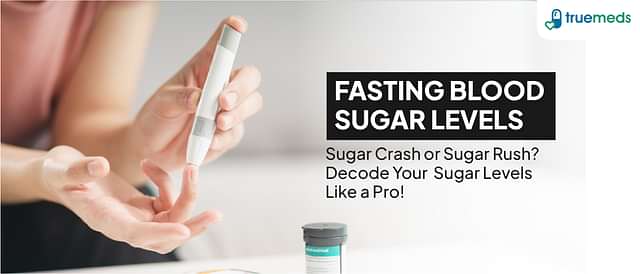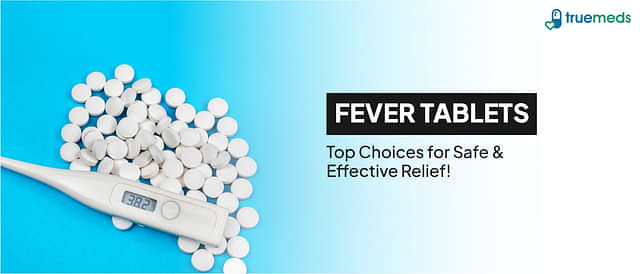Understanding Diabetes Tests: Early Diagnosis of Blood Sugar Level
Last updated on : 21 Mar, 2025
Read time : 8 min
In the journey towards good health, understanding diabetes tests play a crucial role. These tests help detect and manage diabetes at its earliest stages, offering a chance for proactive intervention.
Early diabetes diagnosis is like a guiding light, helping us make informed choices to keep our blood sugar levels in check. This blog digs into diabetes tests, shedding light on the types available, their significance, and how they contribute to a healthier lifestyle.
Whether you’re already on a diabetes management journey or just seeking to learn more about maintaining optimal health, this guide will equip you with the knowledge to navigate the realm of blood sugar monitoring. Let’s unravel the power of tests that empower us to take charge of our well-being and foster a life of balance and vitality.
Diabetes diagnosis tests
Diabetes diagnosis tests are essential tools that healthcare professionals use to assess your blood sugar levels and determine if you have diabetes or are at risk of developing it. These tests are crucial for early detection and effective management of the condition. Here are some common diabetes diagnosis tests:

1) Fasting blood sugar test (FBS)
This FBS test is usually performed in the morning after an overnight fast. It measures your blood sugar level before you’ve eaten anything. On two occasions, a fasting blood sugar of 126 milligrams per deciliter (mg/dL) or above indicates diabetes. This test helps assess your baseline blood sugar levels and identifies potential fasting hyperglycemia.
2) Oral glucose tolerance test (OGTT)
The OGTT involves having a sugary solution, and your blood sugar is measured before and at intervals after consuming the drink. It helps determine how your body responds to glucose and identifies impaired glucose tolerance or diabetes. If your blood sugar level reaches 200 mg/dL or above two hours after the test, it indicates diabetes.
3) Haemoglobin A1c test (HbA1c)
The HbA1c test checks your average blood sugar over the past two to three months. It measures the percentage of haemoglobin that has glucose attached to it. An HbA1c level of 6.5% or above indicates diabetes. This test offers a broader view of your blood sugar control and helps track the effectiveness of your diabetes management over time.
4) Random blood sugar test
This test involves checking your random blood sugar normal range at any time, regardless of when you last ate. It’s often used for diabetes diagnosis in emergencies. A blood sugar level of 200 mg/dL or above, along with signs of diabetes like increased thirst and urination, indicates diabetes. To understand more about the roles of hormones in regulating blood sugar, read our article on insulin and glucagon function.
Additional tests and considerations
In addition to the commonly used diabetes test, several other tests and considerations play a significant role in diagnosing and managing diabetes. These tests provide valuable insights into your overall health and help doctors make informed decisions about your treatment plan.
1) Glycated albumin (GA) test
This test measures the glycated albumin level (a type of protein that has become bound to glucose molecules) in your blood. It offers a snapshot of your blood sugar control over the past few weeks and can help assess short-term changes in blood sugar levels.
2) C-peptide test
The C-peptide test measures the amount of C-peptide, a molecule produced when insulin is created in the body. It helps determine whether your body is producing insulin on its own or if you require insulin therapy.
3) Islet autoantibodies test
This diabetes test detects type 1 diabetes and identifies the presence of autoantibodies that attack insulin-producing cells in the pancreas.
4) Urinalysis
Urinalysis checks for the presence of glucose and ketones in your urine. High levels of glucose or ketones can indicate uncontrolled diabetes or diabetic ketoacidosis, a severe complication.
5) Lipid profile
Diabetes is often connected with an increased risk of cardiovascular problems. A lipid profile measures your cholesterol levels, including LDL, HDL, and triglycerides, providing insights into your heart health.
6) Blood pressure measurement
Monitoring blood pressure is crucial for individuals with diabetes, as high blood pressure can lead to various complications. Regular blood pressure checks help assess your cardiovascular health.
Importance of early detection
Early diabetes diagnosis is crucial for several reasons. Firstly, diabetes is a condition where blood sugar levels are consistently high, which can lead to various health complications over time. Detecting it early allows timely intervention and management to prevent or delay these complications.
Secondly, diabetes often develops gradually, and symptoms might not be apparent initially. By the time noticeable symptoms appear, the condition might have already progressed. Regular screenings and tests, especially for those with risk factors like family history, overweight, or sedentary lifestyle, can catch diabetes before it worsens.
Furthermore, early detection provides an opportunity to make necessary lifestyle changes, such as adopting a balanced diet and increasing physical activity. These changes can significantly improve blood sugar control and may even prevent the need for medication. Therefore, regular check-ups, diabetes screenings, and adhering to a structured sugar patient diet chart are essential to catch the condition and ensure effective management.
Conclusion
Understanding early diabetes diagnosis is vital for maintaining good health. Regular screenings, encompassing fasting blood sugar tests, oral glucose tolerance tests, and HbA1c tests, provide insights into your blood sugar levels and potential risks. Additional tests like glycated albumin, C-peptide, and urinalysis offer a comprehensive view.
By detecting diabetes early, you empower yourself to take proactive steps to manage the condition, make lifestyle changes, and prevent complications. Knowledge is the first step towards effective diabetes management, allowing you to lead a healthier and more fulfilling life.
You can download our user-friendly Truemeds app for easy access to medicine at low rates. Submit your prescription to our platform to receive branded and generic medications. Enjoy savings on purchases and the added convenience of free home delivery on relevant orders across India*.
Frequently asked questions
Age-specific normal HbA1c levels may vary, being below 5.7% for adults without diabetes and between 7.0% and 8.0% for adults with diabetes.
A normal HbA1c level of around 5.5% to 5.7% is considered good.
A normal sugar test measures your current blood sugar level, while HbA1c reflects your average blood sugar over a few months.
Adults’ normal blood sugar should be around 70 to 100 mg/dL before meals.
After a meal, a maximum blood sugar level should ideally stay under 180 mg/dL.
The recommended sugar limit for individuals with diabetes is usually around 180 mg/dL.
Signs of a diabetic emergency include extreme thirst, rapid breathing, and confusion.
Signs of high blood sugar (hyperglycemia) include increased thirst, frequent urination, and fatigue.
Foods that can help lower blood sugar rapidly include leafy greens, cinnamon, and chia seeds.
The 10 warning signs of diabetes include increased thirst, frequent urination, unexplained weight loss, fatigue, blurred vision, slow healing, tingling in hands and feet, frequent infections, excessive hunger, and darkened skin patches. If experiencing multiple symptoms, consult a healthcare professional.
Early pre-diabetes is characterised by slightly elevated blood sugar levels, often between 100 and 125 mg/dL.
The primary cause of diabetes is a mixture of genetic and lifestyle factors, like obesity and lack of physical activity.
Disclaimer
The content provided within this article has been thoroughly verified for accuracy. However, it is advised to consult a doctor before utilising any medication or dietary supplements mentioned herein.
References
- Vasavada A, Taub LFM. Diabetes Mellitus Screening. [Updated 2022 Oct 31]. In: StatPearls [Internet]. Treasure Island (FL): StatPearls Publishing; 2023 Jan-. [Cited on: 2023 August 14]. Available from: https://www.ncbi.nlm.nih.gov/books/NBK554615/
- Genuth SM, Palmer JP, Nathan DM. Classification and Diagnosis of Diabetes. In: Cowie CC, Casagrande SS, Menke A, et al., editors. Diabetes in America. 3rd edition. Bethesda (MD): National Institute of Diabetes and Digestive and Kidney Diseases (US); 2018 Aug. CHAPTER 1. [Cited on: 2023 August 14]. Available from: https://www.ncbi.nlm.nih.gov/books/NBK568014/
- Mearns H, Otiku PK, Shelton M, Kredo T, Kagina BM, Schmidt BM. Screening strategies for adults with type 2 diabetes mellitus: a systematic review protocol. Systematic Reviews. 2020 Dec;9(1):1-1. [Cited on: 2023 August 14]. Available from: https://www.ncbi.nlm.nih.gov/pmc/articles/PMC7359237/
Disclaimer
Our healthcare experts have carefully reviewed and compiled the information presented here to ensure accuracy and trustworthiness. It is important to note that this information serves as a general overview of the topic and is for informational purposes only. It is not intended to diagnose, prevent, or cure any health problem. This page does not establish a doctor-patient relationship, nor does it replace the advice or consultation of a registered medical practitioner. We recommend seeking guidance from your registered medical practitioner for any questions or concerns regarding your medical condition.
Popular Articles
Recent Articles
Top-Selling Medicines:
...View more
Top-Selling OTC:
...View more
Company
About UsHealth ArticleHealth StoriesDiseases & Health ConditionsAyurvedaAll MedicinesAll BrandsNeed HelpFAQSubscribe
Registered Office Address
Grievance Officer
Download Truemeds

Contact Us
Our customer representative team is available 7 days a week from 9 am - 9 pm.
v3.7.31
2025 - Truemeds | All rights reserved. Our content is for informational purposes only. See additional information.
Our Payment Partners









































